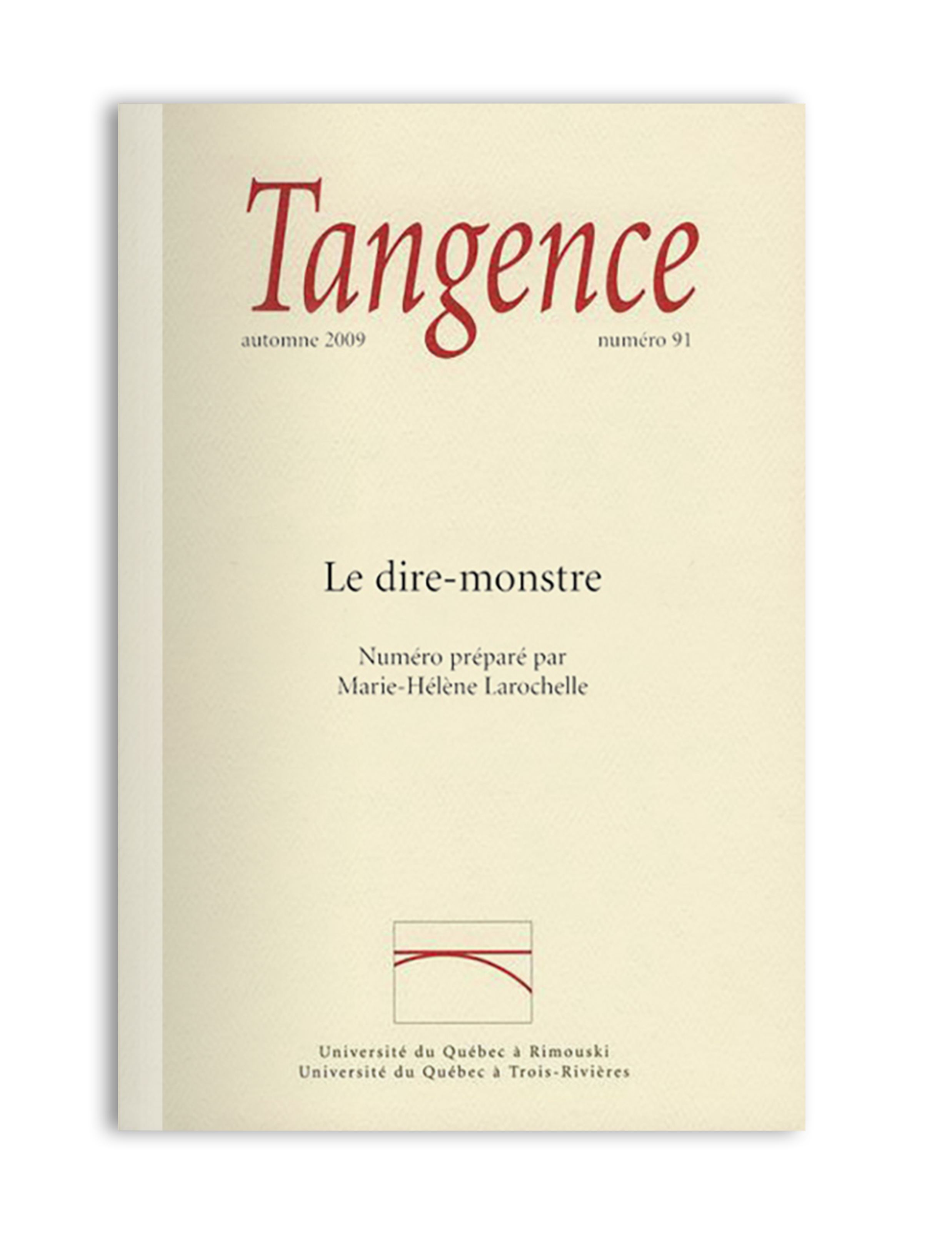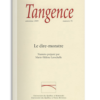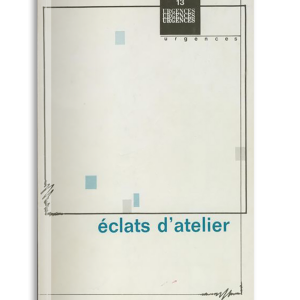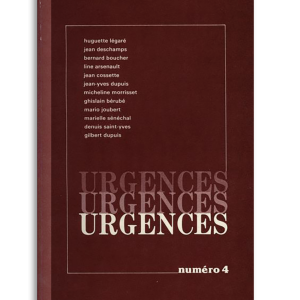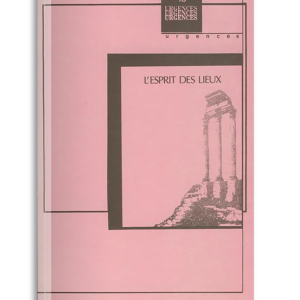N° 91, automne 2009
Le dire-monstre
René Audet
Lieux et pragmatique de la monstruosité dans la prose narrative d’Éric Chevillard
Cet article interroge les types de manifestations de la monstruosité dans la prose narrative d’Éric Chevillard (Scalps et Démolir Nisard). Questionnant ses lieux (déclaration de la monstruosité de personnages par l’instance narrative) et sa dynamique dans les œuvres (la violence révélant une performativité déterminante dans l’établissement d’individus monstrueux), il permet de mieux comprendre le déplacement et la subversion associés à la virulence langagière et au dire-monstre dans les récits mis en place par Chevillard.
Places and pragmatics of monstrosity in the narrative prose of Éric Chevillard
This article examines the types of manifestations of monstrosity in the narrative prose of Éric Chevillard (Scalpsand Démolir Nisard). Focusing on monstrosity’s places (the narrative authority’s statement of the characters’ monstrosity) and dynamic in the works (violence that reveals a determinative performativity in the establishment of monstrous individuals), the article allows for a better understanding of the displacement and subversion associated with linguistic virulence and monster-speak in the accounts Chevillard puts into place.
***
Fabienne Claire Caland
Parole de tête, parole de cœur. L’a-humain, l’immonde et l’humabestial
Préoccupé par les questions de l’identité et de la subjectivité, le XXe siècle a élu deux grandes figures symboliques pour permettre à l’homme de se dire et de se définir : d’un côté, l’a-humain, de l’autre, l’abject (Julia Kristeva) et l’immonde (Jean Clair). Aujourd’hui, ces figures ne suffisent plus. À l’heure de la surexposition de l’individu au détriment de la collectivité, du zapping comme relation privilégiée au monde et d’une violence symbolique de plus en plus crue, une nouvelle figure prend de l’envergure pour interroger notre humanité : « l’humabestial », qui fonctionne sur le principe de l’alternatif. Comment cette nouvelle déclinaison, prise dans les rets du mythique et adaptée à nos sociétés occidentales, peut-elle s’imposer ? Par persuasion (parole de tête), ou par empathie (parole de cœur) ? À nous d’en mesurer l’étendue, les enjeux, les implications ontologiques.
Word of mind, word of heart. A-humanity, vile humanity and bestial humanity
Preoccupied by issues of identity and subjectivity, the twentieth century elected two key symbolic figures to enable Man to claim and define himself : on one side, the a-human, on the other, the abject (Julia Kristeva) and the vile (Jean Clair). Today, these figures no longer suffice. At a time when the individual is overemphasized at the expense of the collectivity, when zapping is considered a privileged relationship to the world and symbolic violence has become increasingly raw, a new figure for examining our humanity is gaining ground : “the bestial human”, who functions on the principle of the alternative. How can this new declension, which is derived from the myth and adapted to our Western societies, establish itself ? Through persuasion (word of mind), or empathy (word of heart) ? It is up to us to measure the extent, the stakes, the ontological implications.
***
Bernard Andrès
L’humain fait monstre chez Pierre de Sales Laterrière (1743-1815) et Jacques Grasset de Saint-Sauveur (1757-1810)
En racontant, vers 1812, sa vie professionnelle et amoureuse au Québec puis au Bas-Canada, Pierre de Sales Laterrière défie les préjugés de ses contemporains, au point que l’édition posthume de ses Mémoires sera expurgée des détails jugés trop « scabreux » par l’abbé Casgrain. Certains de ces passages échappèrent toutefois à la censure. Ils concernent les dessous de la formation médicale, les expériences cliniques et les dissections auxquelles se livraient alors les carabins, tant à Paris qu’à Boston ou à Trois-Rivières. En examinant la façon dont le mémorialiste met en scène le « sujet » médical à des fins satiriques et polémiques, on observera les seuils de tolérance de la société canadienne sous le régime anglais, alors que la colonie s’éveille aux Lumières sur fond de révolutions (américaine et française), puis de guerres napoléoniennes.
The human is monstrous in Pierre de Sales Laterrière (1743-1815) and Jacques Grasset de Saint-Sauveur (1757-1810)
By recounting, circa 1812, his professional and love life in Québec, then in Lower Canada, Pierre de Sales Laterrière defied the prejudices of his contemporaries’ to the extent that the posthumous edition of his Memoirs would be expunged of details the abbé Casgrain deemed too “scabrous.” Some of these passages, however, escaped the censor’s pen. These involve the underside of medical training, the clinical experiments and dissections practiced at the time by medical students, whether in Paris, Boston or Trois-Rivières. By examining how the memoirist highlights the medical “subject” for satirical and polemical purposes, we can observe the thresholds of tolerance of Canadian society under English rule, during a period when the colony was awakening to the Enlightenment against the background of the American and French revolutions, and then the Napoleonic wars.
***
Michel Maffesoli
La barbarie à visage humain : les tribus postmodernes
Plutôt que de dire, sempiternellement, ce que « doit-être » le monde, la société et l’individu, il importe de s’attacher à « monstrer » ce QUI EST, même le monstrueux. Il peut s’agir là une manière d’homéopathiser la violence structurelle de notre humaine nature.
Barbarism with a human face : the postmodern tribes
Rather than repeatedly saying what the world, society and the individual “must be”, the important thing is to endeavor to “monsterize” that which IS, even the monstrous. This could be a way of homeopathizing the structural violence of our human nature.
***
Yvonne Y. Hsieh
Famille et filiation dans le théâtre expérimental de Noëlle Renaude
Les œuvres théâtrales de Noëlle Renaude (née à Paris en 1949) s’insèrent dans le courant contemporain que les critiques ont baptisé « le théâtre de voix ». Dans ce théâtre d’avant-garde, la parole dramatique peut se passer de situations, de personnages bien définis, et de didascalies. La parole n’est plus l’instrument de l’action : elle est l’action. Chaque énonciation génère ses propres temps et espace. Comment susciter et retenir l’intérêt des lecteurs lorsqu’on écrit un texte théâtral sans situations ni fable ? Comment assurer la lisibilité de textes aussi fragmentés ? Dans les pièces de Noëlle Renaude, on constate la récurrence de quelques motifs — notamment la famille et la filiation — qui servent à compenser l’éclatement radical de la forme dramatique, en créant une apparence de profondeur psychologique ainsi que l’illusion d’une dimension spatio-temporelle.
Family and relationship in the experimental plays of Noëlle Renaude
The plays of Noëlle Renaude (born in Paris in 1949) fall within the contemporary wave that critics have christened “voice theatre.” In this avant-garde theatre, dramatic speech can do without situations, well-defined characters and stage direction. Speech is no longer the instrument of action : it is the action. Each pronouncement generates its own time and space. How does one arouse and retain the interest of readers when writing a play with neither situations nor a story ? How can the legibility of such fragmented texts be ensured ? In the plays of Noëlle Renaude, one observes the reoccurrence of a few motifs — notably the family and relationship — which serve to compensate for the radical breakdown of dramatic form by creating an appearance of psychological depth as well as the illusion of a spatio-temporal dimension.
***
Lori Saint-Martin
Figures du père dans le cinéma québécois contemporain
Présente depuis longtemps dans le cinéma québécois, la relation père-enfant, et surtout père-fils, revient en force dans les années 2000. Grâce à l’analyse de six films, le présent article brosse un portrait de la représentation des pères et de la paternité, entre persistance des vieux schémas et images renouvelées. Il s’attarde tant aux promesses d’évolution — naissance d’une parole père-fils, images de réconciliation — qu’aux apories troublantes qui traversent le corpus (pères morts ou malades, mère marginalisée ou effacée, fils hésitant à devenir pères).
Figures of the father in contemporary Québec cinema
Long a feature of Québec cinema, the father-child relationship returned in force during the 2000s. The present article analyzes six films to paint a portrait of the representation of fathers and fatherhood through the persistence of old schemas and renewed images. It dwells on the promises of evolution — the birth of a father-son speech, images of reconciliation — as well as the troubling aporias present throughout the corpus (sick or deceased fathers, marginalized or self-effacing mother, sons reluctant to become fathers).

